Is Humic Acid Fertilizer Better Than Chemical Fertilizer for Sustainable Agriculture
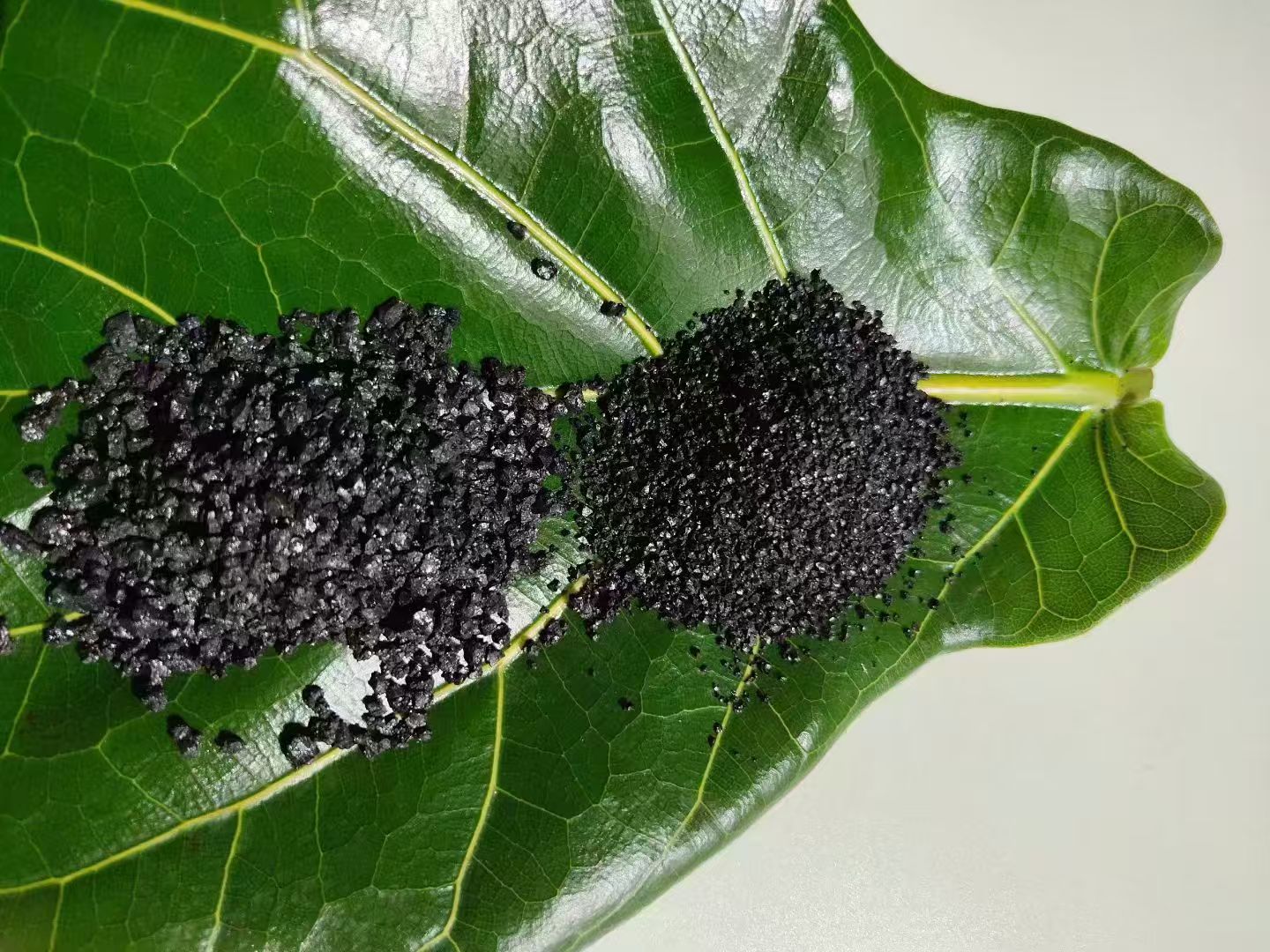
Research shows humic acid fertilizer helps sustainable agriculture more than chemical fertilizers. It gives quick benefits like more crops and better nitrogen use. Over time, soil with humic acid fertilizer gets better structure and keeps more nutrients. The table below shows the main differences:
Metric | Humic Acid Fertilizer vs. Chemical Fertilizer | Time Frame |
|---|---|---|
Soil cation exchange capacity | 136% increase | Long-term (20 years) |
Crop yield | 12% increase | Immediate |
Nitrogen uptake | 17% increase | Immediate |
Nitrogen use efficiency | 27% increase | Immediate |
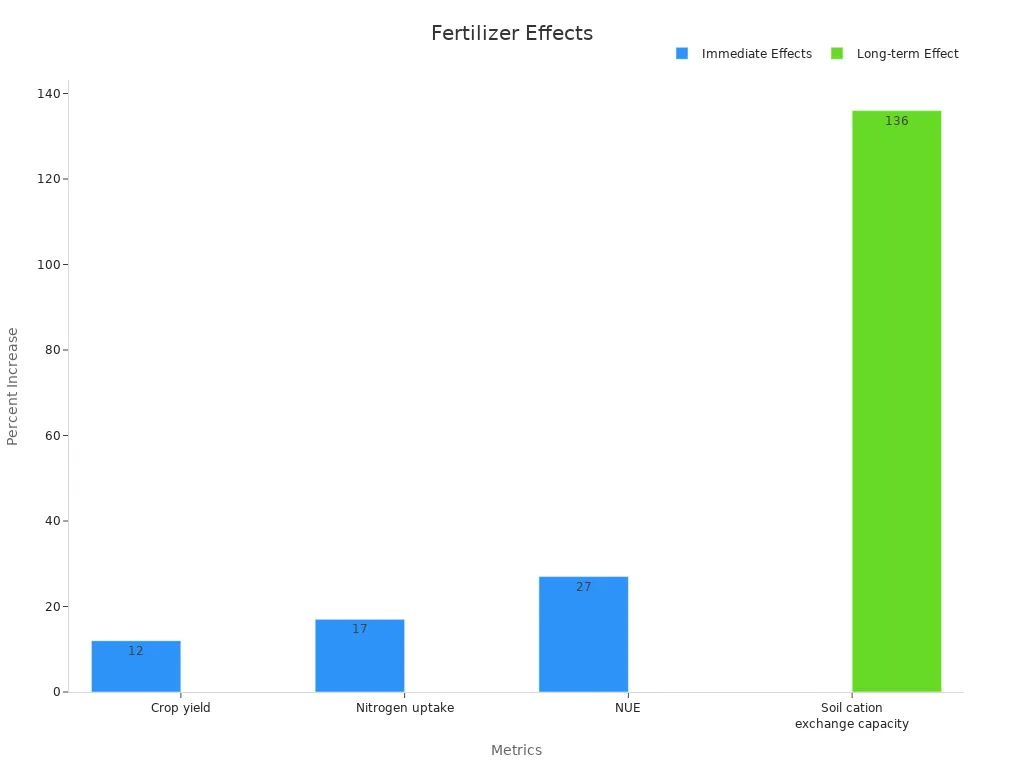
Key Takeaways
Humic acid fertilizer makes soil healthier. It helps soil hold more water. It gives plants more nutrients. It helps good microbes grow. This makes plants stronger and crops better.
Using humic acid fertilizer with chemical fertilizer is helpful. Plants use nutrients better this way. It also helps farms be more sustainable. It causes less harm to the environment.
Humic acid fertilizer gives out nutrients slowly. This lowers the risk of pollution. It stops water runoff and keeps water clean.
Humic acid fertilizer costs more at first. But it saves money later. Farmers need less extra fertilizer, pesticides, and water.
Farmers get the best results by testing soil often. They should use humic acid fertilizer the right way. They can also use it with chemical fertilizers if needed.
Nutrient Supply
Humic Acid Fertilizer
Humic acid fertilizer is made from old plant and animal matter. It has humic substances that help soil and plants in many ways.
It makes the soil better and helps it hold more water.
It helps plants take in more nutrients and grow strong roots.
It helps tiny living things in the soil break down nutrients for plants.
It lets the soil hold on to nutrients like nitrogen, phosphorus, and potassium for longer.
It grabs onto minerals, so plants can use them more easily and keeps heavy metals from hurting plants.
Tests in fields show that using humic acid fertilizer with minerals like attapulgite helps the soil keep more water and nutrients. It also adds more organic carbon to the soil. These changes help plants get more nutrients as time goes on. Studies say humic acid fertilizer helps plants take in more nutrients and grow better, even in salty soils.
Chemical Fertilizer
Chemical fertilizers give nutrients straight to plants. They have nitrogen, phosphorus, and potassium that plants can use right away.
They help plants grow fast and make more crops quickly.
They do not make the soil better or add organic matter.
Using only chemical fertilizers for a long time can lower organic matter and hurt good microbes in the soil.
Soil with just chemical fertilizers can get hard and not hold water or nutrients well.
The table below shows how chemical and organic fertilizers are different in giving nutrients:
Parameter | Chemical Fertilizer | Humic Acid/Organic Fertilizer |
|---|---|---|
Nitrogen Utilization | Baseline | |
Phosphorus Utilization | Baseline | Up to 122% higher |
Soil Organic Matter | Lower | Higher |
Soil Structure | No improvement | Improved |
Crop Yield
Crop yield depends on how well plants get nutrients. Studies show humic acid fertilizer can raise crop yield by about 12% more than just chemical fertilizer. It also helps plants use nitrogen better by 27% and take in more nitrogen by 17%. These good effects happen in many crops, like cash crops and cereals. Using both humic acid fertilizer and chemical fertilizer together often works best. This way, farmers get more crops and healthier soil.
Tip: Farmers can get better crops now and later if they use humic acid fertilizer with chemical fertilizer, instead of just using chemicals.
Soil Health
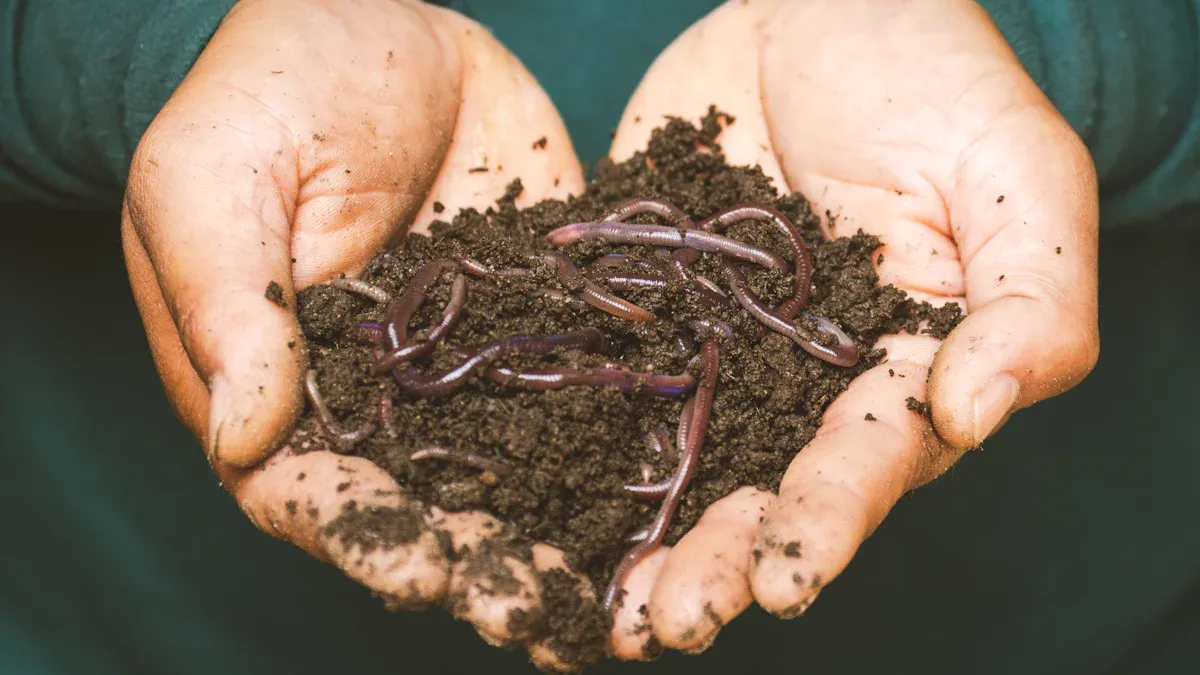
Soil Structure
Healthy soil lets plants grow strong roots. It helps plants take in water and nutrients. Humic acid fertilizer adds organic matter to the soil. This makes the soil softer and helps it hold more water. In a three-year test in Shandong, China, scientists saw big changes. Soil with humic acid fertilizer had more organic matter and nutrients. It also had better enzyme activity. Enzymes help break down nutrients for plants. Peanut yield went up by over 78% after three years. The soil was less packed and roots could grow easier.
Good soil structure helps plants grow and stops soil from washing away.
Microbial Life
Soil has many tiny living things called microbes. These microbes break down dead plants and animals. They make nutrients for crops. Humic acid fertilizer helps these good microbes. The same study in China showed changes in the soil’s microbes. More good microbes grew and bad ones went down. This made the soil healthier and helped crops fight disease. Chemical fertilizers do not help microbes like humic acid fertilizer does. Using only chemical fertilizers can lower the number of good microbes.
Humic acid fertilizer boosts enzyme activities like urease and sucrase.
These enzymes help give plants the nutrients they need.
More microbes mean healthier soil and stronger plants.
Long-Term Fertility
Long-term fertility means soil can grow crops every year. Studies show humic acid fertilizer can triple soil organic matter. These studies also found more soil carbon, nitrogen, phosphorus, and potassium. The soil keeps more nutrients and grows more plants. Humic acid holds onto nutrients and makes them easier for plants to use. It also helps soil keep water and handle dry or rainy weather.
A test on lawns showed humic acid fertilizer made soil and plants better over time. The lawns needed less chemical fertilizer and stayed green and healthy. This means humic acid fertilizer helps soil stay healthy for years and cuts down on chemicals.
Tip: Farmers who use humic acid fertilizer can keep their soil healthy for many years and grow better crops with less chemical input.
Environmental Impact
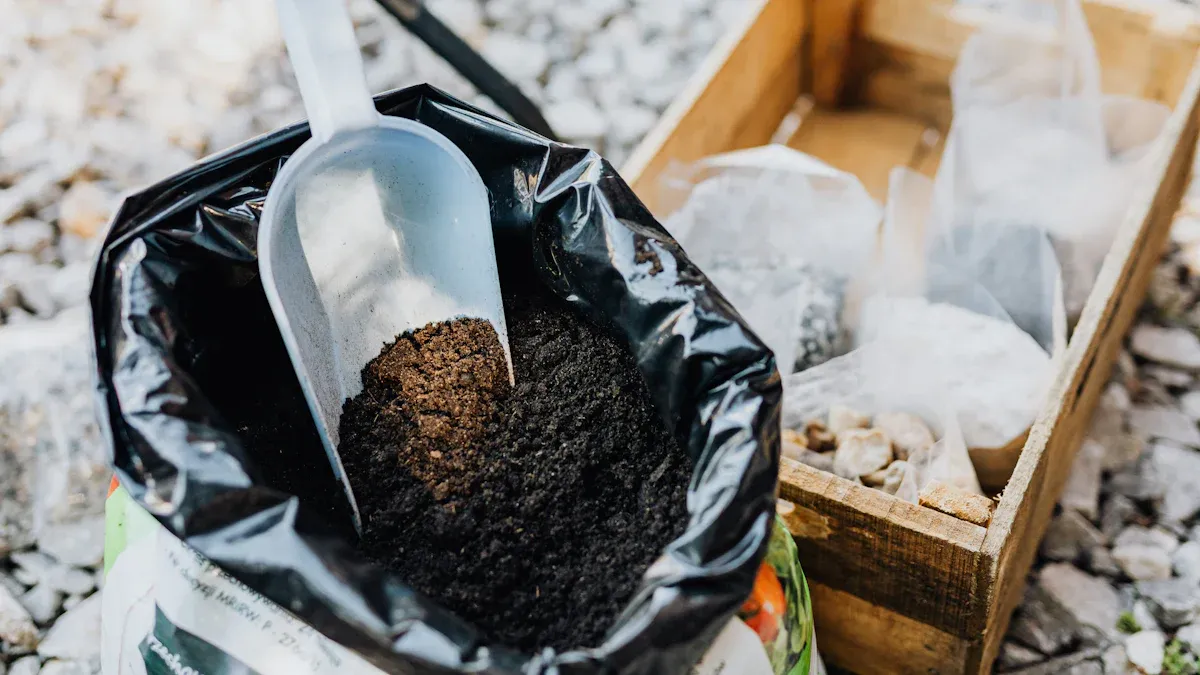
Pollution Risks
Chemical fertilizers can pollute water when it rains. Rainwater can wash nutrients off the fields. These nutrients, like nitrogen and phosphorus, go into rivers and lakes. Too many nutrients make algae grow fast. This can hurt fish and make water dirty. Chemical fertilizers can also get into groundwater. This can raise nitrate levels and make water unsafe to drink.
A study from 2007 to 2022 looked at heavy metals in soil and wheat. The study showed chemical fertilizers did not add more heavy metals to soil. Organic fertilizers, including some with humic substances, did add more heavy metals. These metals were cadmium, chromium, and lead. But the amounts stayed under safety limits. Wheat grains did not have more heavy metals. So, food safety and health risks stayed low, even with more heavy metals in soil.
Farmers should not use too much fertilizer. Using too much, even organic or chemical, can still hurt the environment.
Sustainability
Sustainable farming means growing crops and caring for the land. Humic acid fertilizer helps by making soil better and holding nutrients longer. It gives nutrients slowly, so plants use them over time. This means farmers do not need to add fertilizer as often.
The table below shows how humic acid fertilizer and chemical fertilizers compare:
Metric | Humic Acid Fertilizer | Chemical Fertilizer |
|---|---|---|
Fertilizer loading rate | Lower | |
Slow-release performance | 288 hours (12 days) | Fast release, short duration |
Soil water retention capacity | +824.3% | Minimal change |
Plant growth and germination | +133% | Baseline |
Environmental impact (LCA) | Minimal footprint | Higher footprint |
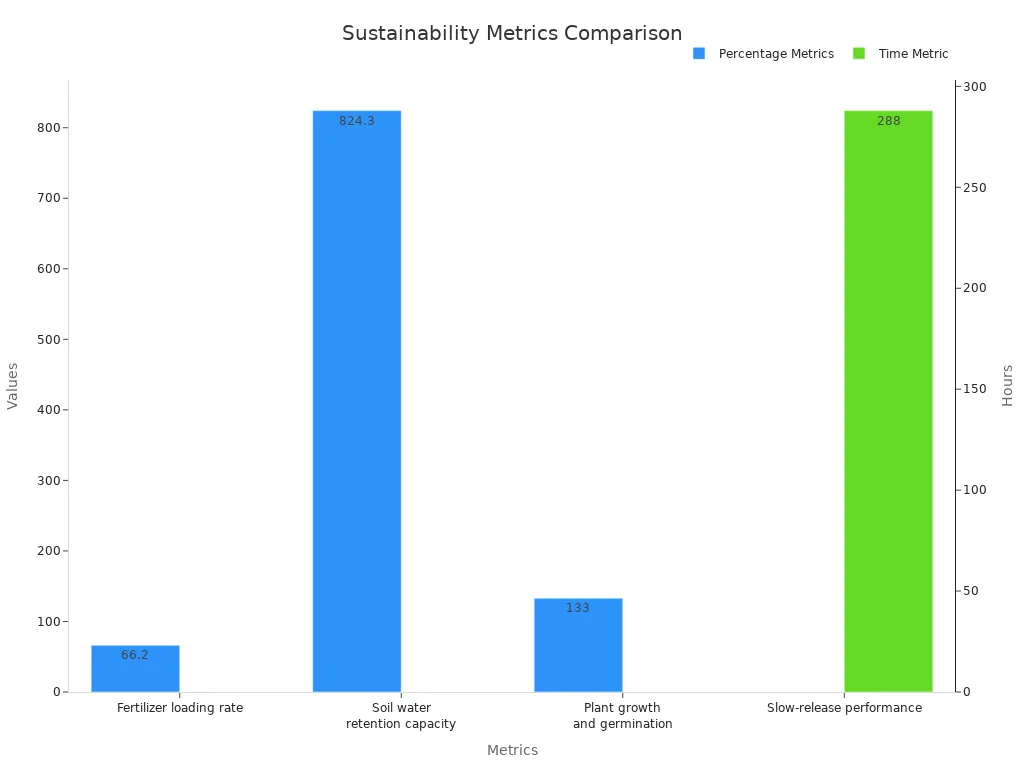
Humic acid fertilizer helps soil hold more water, up to 48% more. It also helps plants use nitrogen better, up to 66% more. Because it releases nutrients slowly, less fertilizer washes away in rain. This protects the environment and saves money for farmers.
Water Quality
Water quality depends on what goes into rivers and lakes from farms. Chemical fertilizers can cause problems if nutrients run off fields. This runoff can make algae grow and lower oxygen in water. Fish and other animals can get hurt.
Humic acid fertilizer makes soil healthier, which helps stop runoff. Studies show fields with humic substances have more microbes and organic matter. This helps soil keep nutrients and water, so less washes away. Some important results are:
Microbial biomass carbon went up by 30% with humic fertilizer.
Microbial biomass nitrogen went up by 40%.
Soil organic matter grew from 0.4% to 0.7% with humic fertilizer.
Humic acid fertilizer can cut nitrogen loss and help plants use nutrients.
Healthy soil works like a sponge. It keeps nutrients in place and keeps water clean.
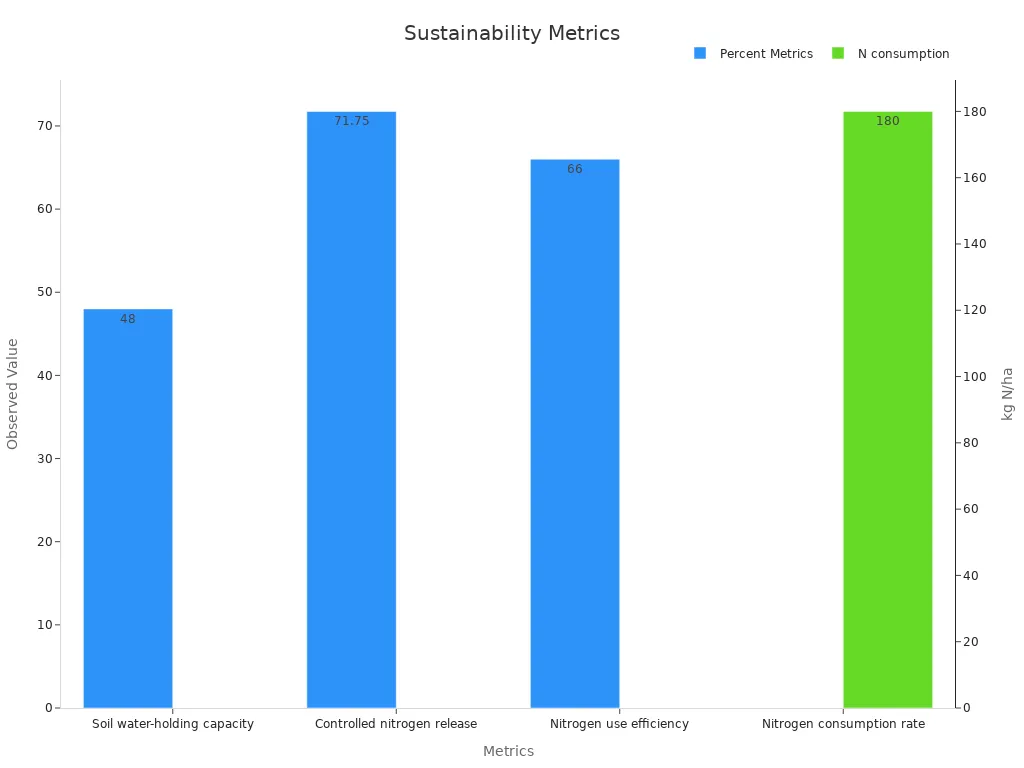
Cost and Value
Upfront Costs
Farmers usually check the price first. Humic acid fertilizer costs more per bag than chemical fertilizer. This is because making humic acid fertilizer takes more work. Companies use natural materials and special steps to make it. Chemical fertilizers, like urea or NPK, are cheaper. Factories can make them fast and in big amounts.
Fertilizer Type | Average Cost per Ton (USD) |
|---|---|
Humic Acid Fertilizer | $200–$2000 |
Chemical Fertilizer | $250–$500 |
Note: Prices can be different in each place and depend on quality.
Long-Term Savings
Humic acid fertilizer helps soil keep water and nutrients. This means farmers can use less fertilizer each year. Healthy soil also has fewer bugs and diseases. Over time, farmers spend less on extra fertilizer, bug killers, and water.
Humic acid fertilizer can lower fertilizer use by up to 30%.
Farmers may see fewer weeds and less soil washing away.
Good soil needs less water.
Chemical fertilizers work fast but do not help soil health. Farmers might need to use more every year to get the same crops. This can make costs go up over time.
Return on Investment
Return on investment (ROI) shows how much money farmers make for each dollar spent. Humic acid fertilizer often gives a better ROI after a few years. It helps crops grow, makes soil better, and lowers the need for other farm products.
Benefit | Humic Acid Fertilizer | Chemical Fertilizer |
|---|---|---|
Crop Yield Increase | 8–15% | 5–10% |
Reduced Input Costs | Yes | No |
Soil Health Improvement | Yes | No |
Long-Term Profitability | High | Medium |
Tip: Farmers who buy humic acid fertilizer pay more at first, but they often save money and earn more after a few years.
Practical Use
Application Methods
Farmers have a few ways to use humic acid fertilizer. They pick the best way for their crops and soil.
Liquid foliar spray goes on leaves and helps plants get nutrients fast.
Soil drenching puts nutrients right by the roots.
Granular broadcasting spreads fertilizer all over the field.
How much to use depends on the crop and soil. For liquid, farmers use 1–5 grams in each liter of water. For granular, they use 0.5–2 kilograms for every hectare. When to use it is important. Farmers get the best results if they use humic acid fertilizer at planting or when plants are growing fast. They test the soil often to change how much and which way to use it.
Compatibility
Humic acid fertilizer works with many chemical fertilizers, especially ones with nitrogen. Potassium humate mixes well with most synthetic fertilizers. Farmers often use humic acid fertilizer and nitrogen together at the start of the season. This helps plants use more nutrients and stops them from washing away. Before mixing, they do a jar test to see if there is a problem. The soil pH should be between 6.0 and 7.5 for the best results. If the soil is too sour or too basic, plants cannot get as many nutrients.
Note: Farmers should not mix humic acid fertilizer with strong acids or very basic products. This keeps bad chemical reactions from happening.
Best Practices
Farmers can get the most out of humic acid fertilizer by doing these things:
Use small soil samples to see how soil changes in different spots.
Put on different amounts of fertilizer to match what each crop needs.
Check plant leaves during the season to see if they need more nutrients.
Try to use nutrients better by at least 5% each year.
Change fertilizer plans if crops grow slow or the weather changes.
A study in China found that using slow-release and regular nitrogen fertilizers with humic acid fertilizer made maize yield higher and helped plants use nitrogen better. This also lowered pollution and saved money.
Tip: Testing soil often and planning ahead helps farmers use humic acid fertilizer well and keeps the environment safe.
Humic Acid Fertilizer Benefits
Soil Health
Good soil helps plants grow well and stay strong. Many studies show humic acid fertilizer makes soil better in many ways.
It helps soil form small clumps called microaggregates. These clumps let air and water move through the soil.
The soil can hold more water, so plants do not dry out fast.
Humic acid acts like a magnet for nutrients. It grabs minerals and helps plant roots use them.
It increases the number of helpful microbes in the soil. These tiny living things break down dead plants and animals. They turn them into food for crops.
All these changes help plants grow better and give more crops.
Scientists and farm experts have seen these good effects in many field tests. They also say humic acid fertilizer helps soil stay healthy for a long time. It means farmers do not need as much chemical fertilizer.
Healthy soil with more organic matter can keep water longer and stop nutrients from washing away.
Crop Resilience
Crops face many problems, like salty soil, dry weather, and not enough nutrients. Humic acid fertilizer helps plants deal with these problems. In one study, scientists tested triticale crops in salty soils. The crops with humic acid grew better and made more grain. They also had more protein and sugar. The fertilizer helped roots grow deeper and stronger. It helped plants take in more nutrients and stay healthy, even in salty soil.
Monty's Plant Food says humic acid fertilizer helps plants use nutrients and grow roots. It also helps crops live through hard times like drought and salty soil. The fertilizer makes soil hold more water and lowers salt in the soil. These changes help crops stay strong and keep growing, even when the weather is not good.
Farmers who use humic acid fertilizer often see stronger plants. These plants can handle stress better and make more food.
Many tests show humic acid fertilizer helps farming more than chemical fertilizer. The table below shows what some studies found:
Study | Key Findings |
|---|---|
Canellas et al., 2013 | Humic acid with microbes makes crops grow more. |
da Piedade et al., 2017 | Humic acid helps roots grow and soil life get better. |
Gryndler et al., 2005 | Humic acid helps good soil organisms like AMF. |
Piccolo et al., 1992 | Humic acid helps plants grow more roots. |
Gryndler et al., 2009 | Humic acid helps plants and AMF work together better. |
Farmers and gardeners can use humic acid fertilizer to make soil better, get more crops, and use fewer chemicals. They should check their soil often and use both kinds of fertilizer if needed. This way, crops grow well now and the soil stays good for a long time.
FAQ
What is the main difference between humic acid fertilizer and chemical fertilizer?
Humic acid fertilizer comes from things like old plants and animals. Chemical fertilizer is made by people in factories. Humic acid makes soil healthier and helps plants use food better. Chemical fertilizer gives plants food fast but does not make soil better.
Can farmers use humic acid fertilizer with chemical fertilizer?
Yes, many farmers use both at the same time. Humic acid helps plants get more food from chemical fertilizer. Using both can help crops grow more and make soil healthier.
Does humic acid fertilizer work for all crops?
Most crops do well with humic acid fertilizer. It works for grains, vegetables, and fruit trees. Farmers should check what their soil and crops need before using it.
Is humic acid fertilizer safe for the environment?
Humic acid fertilizer is safe if used the right way. It helps soil keep food and water, so less washes away. Farmers should not use too much to avoid problems.
See Also
How Potassium Humate Enhances Plant Development Effectively
Exploring Humic And Fulvic Acids Benefits For Plants And Animals
Ten Best Plants Thriving With Humic Acid For Growth
Comprehensive Tips For Purchasing Mineral Humic Acid From China
Sodium Humate’s Impact On Progressing Agriculture And Industry Today
